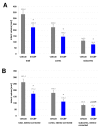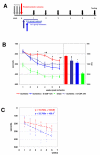An extended window of opportunity for G-CSF treatment in cerebral ischemia
- PMID: 17049076
- PMCID: PMC1633735
- DOI: 10.1186/1741-7007-4-36
An extended window of opportunity for G-CSF treatment in cerebral ischemia
Abstract
Background: Granulocyte-colony stimulating factor (G-CSF) is known as a powerful regulator of white blood cell proliferation and differentiation in mammals. We, and others, have shown that G-CSF is effective in treating cerebral ischemia in rodents, both relating to infarct size as well as functional recovery. G-CSF and its receptor are expressed by neurons, and G-CSF regulates apoptosis and neurogenesis, providing a rational basis for its beneficial short- and long-term actions in ischemia. In addition, G-CSF may contribute to re-endothelialisation and arteriogenesis in the vasculature of the ischemic penumbra. In addition to these trophic effects, G-CSF is a potent neuroprotective factor reliably reducing infarct size in different stroke models.
Results: Here, we have further delayed treatment and studied effects of G-CSF on infarct volume in the middle cerebral artery occlusion (MCAO) model and functional outcome in the cortical photothrombotic model. In the MCAO model, we applied a single dose of 60 microg/kg bodyweight G-CSF in rats 4 h after onset of ischemia. Infarct volume was determined 24 h after onset of ischemia. In the rat photothrombotic model, we applied 10 microg/kg bodyweight G-CSF daily for a period of 10 days starting either 24 or 72 h after induction of ischemia. G-CSF both decreased acute infarct volume in the MCAO model, and improved recovery in the photothrombotic model at delayed timepoints.
Conclusion: These data further strengthen G-CSF's profile as a unique candidate stroke drug, and provide an experimental basis for application of G-CSF in the post-stroke recovery phase.
Figures


Similar articles
-
Anti-apoptotic effect of granulocyte-colony stimulating factor after focal cerebral ischemia in the rat.Neuroscience. 2006 Dec 28;143(4):965-74. doi: 10.1016/j.neuroscience.2006.09.014. Epub 2006 Nov 2. Neuroscience. 2006. PMID: 17084035 Free PMC article.
-
Strategies to improve post-stroke behavioral recovery in aged subjects.Rom J Morphol Embryol. 2009;50(4):559-82. Rom J Morphol Embryol. 2009. PMID: 19942950
-
Granulocyte colony-stimulating factor regulates JNK pathway to alleviate damage after cerebral ischemia reperfusion.Chin Med J (Engl). 2013 Nov;126(21):4088-92. Chin Med J (Engl). 2013. PMID: 24229679
-
The role of stem cell factor and granulocyte-colony stimulating factor in treatment of stroke.Recent Pat CNS Drug Discov. 2013 Apr;8(1):2-12. doi: 10.2174/1574889811308010002. Recent Pat CNS Drug Discov. 2013. PMID: 23173646 Free PMC article. Review.
-
A role for G-CSF (granulocyte-colony stimulating factor) in the central nervous system.Cell Cycle. 2005 Dec;4(12):1753-7. doi: 10.4161/cc.4.12.2213. Epub 2005 Dec 27. Cell Cycle. 2005. PMID: 16258290 Review.
Cited by
-
G-CSF, rt-PA and combination therapy after experimental thromboembolic stroke.Exp Transl Stroke Med. 2010 Apr 14;2:9. doi: 10.1186/2040-7378-2-9. Exp Transl Stroke Med. 2010. PMID: 20388227 Free PMC article.
-
Cell biology and clinical promise of G-CSF: immunomodulation and neuroprotection.J Cell Mol Med. 2007 Nov-Dec;11(6):1272-90. doi: 10.1111/j.1582-4934.2007.00101.x. J Cell Mol Med. 2007. PMID: 18205701 Free PMC article. Review.
-
The role of granulocyte-colony stimulating factor (G-CSF) in the healthy brain: a characterization of G-CSF-deficient mice.J Neurosci. 2009 Sep 16;29(37):11572-81. doi: 10.1523/JNEUROSCI.0453-09.2009. J Neurosci. 2009. PMID: 19759304 Free PMC article.
-
Granulocyte-colony stimulating factor improves MDX mouse response to peripheral nerve injury.PLoS One. 2012;7(8):e42803. doi: 10.1371/journal.pone.0042803. Epub 2012 Aug 13. PLoS One. 2012. PMID: 22912741 Free PMC article.
-
Bone marrow mesenchymal stem cells can be mobilized into peripheral blood by G-CSF in vivo and integrate into traumatically injured cerebral tissue.Neurol Sci. 2011 Aug;32(4):641-51. doi: 10.1007/s10072-011-0608-2. Epub 2011 Jun 16. Neurol Sci. 2011. PMID: 21678074
References
-
- Begley CG, Lopez AF, Nicola NA, Warren DJ, Vadas MA, Sanderson CJ, Metcalf D. Purified colony-stimulating factors enhance the survival of human neutrophils and eosinophils in vitro: a rapid and sensitive microassay for colony-stimulating factors. Blood. 1986;68:162–166. - PubMed
MeSH terms
Substances
LinkOut - more resources
Full Text Sources
Other Literature Sources

